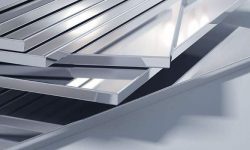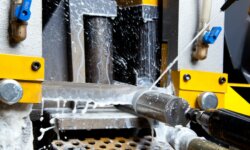Magnesium is a lightweight metal with high level of machinability that can be CNC machined to create parts with high strength and excellent corrosion resistance.
However, magnesium can be difficult to machine due to its tendency to ignite or explode if proper precautions are not taken. It provides a hazard for CNC machinists: the chips and dust from machined magnesium are highly flammable.
Without due caution and preparation, CNC machining magnesium can become a serious safety risk.
This article looks at best practices for safely machining magnesium and other flammable metals. It discusses proper chip removal, preventative measures and other tips for lowering the risk of fire in the machine shop.
Why machine magnesium?
If magnesium can be dangerous, then why machine with it at all? It’s a fair question, but as long as safety guidelines are followed, magnesium can be an excellent material choice for CNC machining.
Magnesium is the lightest structural metal, and it also provides an excellent surface finish when machined.
That’s partly due to magnesium’s excellent machinability. Magnesium requires a much lower cutting force than aluminum, which has numerous benefits for machinists:
- Machining can be carried out quickly
- Chips break cleanly and consistently
- Less power is required
- There is less wear to cutting tools, prolonging their lifespan
Why is magnesium hazardous?
While a magnesium workpiece is very difficult to ignite, the material becomes highly flammable when turned into powder or shavings.
This means the chips from machined magnesium can pose a fire safety risk.
That risk to machine shops is heightened because magnesium-induced fires are very difficult to extinguish. The combustion will persevere in nitrogen, carbon dioxide and water. (This is why magnesium powders have historically been used in some explosive devices.)
Getting the right fire extinguisher
Fires caused by ignited magnesium chips cannot be extinguished with water — water makes things worse — so it is vitally important that a machine shop is prepared to fight fire in a worst-case scenario.
Fire extinguishers are an essential component in any machine shop, and there are several classes of fire extinguisher for different situations.
In the case of a magnesium fire, you will need to use a Class D fire extinguisher, designed specifically for fighting metal fires.
Class D fire extinguishers typically contain an agent such as sodium chloride or copper powder.
Additionally, a bucket of sand can be used to extinguish a metal fire.
Typically, sand can be used to control small fires, while a fire extinguisher should be used on larger flames, when it is not possible to smother the entire fire with sand.
A sand bucket should be kept close to the machine where magnesium will be processed, but the fire extinguisher should be kept a little further away. You otherwise run the risk of losing the extinguisher in the fire.
How to safely machine magnesium?
Although it might sound daunting, it is perfectly safe to CNC machine magnesium if the right precautions are taken.
Avoid tight clearance angles
Although magnesium can be machined at fast speeds without compromising the quality of the part, it is best to avoid tight clearance angles, because contact between the tool and workpiece increases friction and cutting temperature.
Maintain proper tool condition
Sharp cutting tools can reduce the fire hazard of machining magnesium.
Dull tools can rub and cause friction, which causes sparks and builds up heat where the sensitive magnesium chips are being created. Needless to say, sharp tools will also produce better parts.
Most machinists use a carbide cutting tool with a large relief angle for machining magnesium.
Avoid water-based coolant
Although coolants reduce machining temperatures, a water-based coolant can actually increase the risk of a magnesium fire as it will produce hydrogen gas.
Avoid coolant altogether, or use a light mineral oil in place of standard coolant. Compressed air or argon gas can also be used to reduce temperatures without the risk of exacerbating a potential fire.
Make discontinuous chips
When CNC machining magnesium, it is better to make well-broken discontinuous chips, as opposed to more easily ignitable ribbon chips.
Use only explosion-proof chip vacuum
If using a vacuum extraction system for chip removal, this system should be as fireproof as the rest of the machining setup.
Magnesium part and chip storage
Your finished magnesium part is highly unlikely to ignite, but chips need to be treated with due care. Magnesium remains hazardous even after machining is complete.
If possible, chips should be kept dry at all times and stored in closed bins such as steel drums, separate from chips of other materials.
Storage containers should be kept at a distance from flammable materials. If the chips are wet, they should be stored in a remote location like an outdoor storage shed.
Magnesium chips can be recycled in many countries.
While the finished magnesium parts do not need to be kept in a remote location, they should also be kept dry to prevent inflammation.
Other flammable metals
Magnesium is not the only metal capable of causing a fire hazard during CNC machining.
Other combustible materials include titanium which is widely used for machining, as well as sodium and lithium.
Titanium should be treated with the same considerations as magnesium. Only sand and Type D fire extinguishers should be used to extinguish titanium fires, and similar care should be taken to avoid chip buildup.
Machining magnesium with 3ERP
3ERP is an experienced provider of CNC machining services and custom parts and can create parts in magnesium, titanium and many other metals.
Request a quote for your next project.







